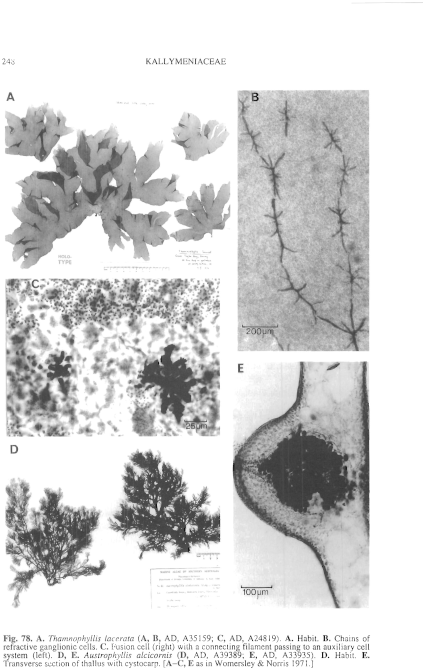|
|
|
|
|
|||||||||||
|
Electronic Flora of South Australia Species Fact Sheet
Phylum Rhodophyta – Class Florideophyceae – Order Gigartinales – Family Kallymeniaceae
Synonyms
Kallymenia polycoelioides J. Agardh 1876: 687. Sonder 1881: 15. Womersley 1973: 255, figs 2–7. Womersley & Norris 1971: 42, fig. 108.
Meredithia polycoelioides (J. Agardh) J. Agardh 1892: 76. Guiler 1952: 89. Lucas 1929a: 17.
Thallus (Fig. 76B) dark red to brown-red, complanate, subdichotomous, to 12 cm high, arising from a short stipe 1–4 mm long; thallus cuneately to broadly expanded to 1–4 cm across at a few cm above the stipe, developing subdichotomous branches 1–1.5 cm broad, and 1–2 cm between dichotomies, with broad, rounded apices or lobes 3–6 mm across; in some plants new subdichotomous lobes arise proliferously from older basal parts; substance fairly soft, adhering closely to paper on drying. Holdfast discoid, 1–3 mm across; epilithic. Structure. Thallus (Fig. 77G) 400–600 µm thick with a cortex 5–7 cells thick and a broad medulla of fairly loosely arranged filaments mostly 7–15 µm in diameter; outer cortical cells fairly compact, 2–4 µm across and isodiametric in surface view, inner cortical cells large; medulla with stellate cells (Fig. 77H) often with numerous arms and lightly to moderately staining.
Reproduction: Carpogonial branch systems (Fig. 77G) monocarpogonial, the supporting cell lobed and usually bearing four lobed subsidiary cells and a 3-celled carpogonial branch, the first cell of which is lobed and the second elongate. Fusion cell lobed. Auxiliary cell systems (Fig. 771) relatively small, 25–50 µm across, consisting of an auxiliary cell bearing about 8 subspherical subsidiary cells each of which often bears one further cell. Cystocarps scattered, about 2 mm in diameter (in the type).
Male and tetrasporangial thalli unknown.
Type from Orford, Tas. (Meredith); holotype in Herb. Agardh, LD, 24843.
Distribution: South-eastern Tasmania. As well as the type, two further Tasmanian collections are known , from Fluted Cape, Bruny I., 23 m deep (Shepherd, 12.ii.1972; AD, A41925), and Great Taylor Bay, Bruny I., 2–5 m deep (Shepherd, 14.ii.1972; AD, A42131).
Taxonomic notes: This species was previously placed in Kallymenia, but the subdichotomous thallus is more indicative of Cirrulicarpus. However, the texture is not cartilaginous as in other species of Cirrulicarpus but soft as in most species of Kallymenia; the relationships of these two genera need further study, but since some species of Kallymenia are subcartilaginous (e.g. K. tasmanica) it seems best to use the thallus branching of Cirrulicarpus as the main generic feature. Division of the tetrasporangia, when known, may clarify the generic position.
KALLYMENIACEAE 243
References:
AGARDH, J.G. (1876). Species Genera et Ordines Algarum. Vol. 3, Part 1 - Epicrisis systematis Floridearum, pp. i-vii, 1–724. (Weigel: Leipzig.)
AGARDH, J.G. (1892). Analecta Algologica. Acta Univ. lund. 28, 1–182, Plates 1–3.
GUILER, E.R. (1952). The marine algae of Tasmania. Check-list with localities. Pap. Proc. R. Soc. Tasm. 86, 71–106.
LUCAS, A.H.S. (1929a). The marine algae of Tasmania. Pap. Proc. R. Soc. Tasm. 1928, 6–27.
SONDER, O.W. (1881). In Mueller, F., Fragmenta Phytographiae Australiae. Supplementum ad volumen undecinum: Algae Australianae hactenus cognitae, pp. 1–42, 105–107. (Melbourne.)
WOMERSLEY, H.B.S. & NORRIS, R.E. (1971). The morphology and taxonomy of Australian Kallymeniaceae (Rhodophyta). Aust. J. Bot. Suppl. 2, pp. 1–62.
WOMERSLEY, H.B.S. (1973). Further studies on Australian Kallymeniaceae (Rhodophyta). Trans. R. Soc. S. Aust. 97, 253–256.
The Marine Benthic Flora of Southern Australia Part IIIA complete list of references.
Publication:
Womersley, H.B.S. (14 January, 1994)
The Marine Benthic Flora of Southern Australia
Rhodophyta. Part IIIA, Bangiophyceae and Florideophyceae (to Gigartinales)
Reproduced with permission from The Marine Benthic Flora of Southern Australia Part IIIA 1994, by H.B.S. Womersley. Australian Biological Resources Study, Canberra. Copyright Commonwealth of Australia.
Illustrations in Womersley Part IIIA, 1994: FIGS 76B, 77 G–I.

Figure 76 enlarge
Fig. 76. A. Cirrulicarpus nanus (AD, A33913). Habit. B. Cirrulicarpus polycoelioides (AD, A41925). Habit. C, D. Hormophora australasica (C, AD, A46592; D, AD, A49150). C. Habit. D. Cross section of a cystocarp. E. Polycoelia laciniata (AD, A19401). Habit. [E as in Womersley & Norris 1971.]

Figure 77 enlarge
Fig. 77. A–F. Cirrulicarpus nanus (A–D, MEL, 1OO5814; E, AD, A41232; F, AD, A42423). A. Transverse section of thallus, with a carpogonial branch system. B. Stellate cell. C. Carpogonial branch system with 3 carpogonial branches. D. Auxiliary cell system. E. Transverse section of cortex with spermatangia. F. Transverse section of cortex with obliquely divided telrasporangia. G–L. Cirrulicarpus polycoelioider (AD, A41925). G. Transverse section of cortex with a carpogonial branch system. H. Stellate cell. I. Auxiliary cell system. J–L. Hormophora auslralasica (J, K, from the type; L, AD, A4915O). J. Transverse section of thallus. K. Stellate cell. L. Carpogonial branch system. M–O. Polycoelia laciniaza (M, N, AD, A212O9; O, AD, A19401). M. Transverse section from large central cells to cortex, with tetrasporangia. N. Carpogonial branch system. O. Auxiliary cell system. [A–D, J, K, M after Womersley & Norris 1971.]

|
Email Contact: State Herbarium of South Australia |

|